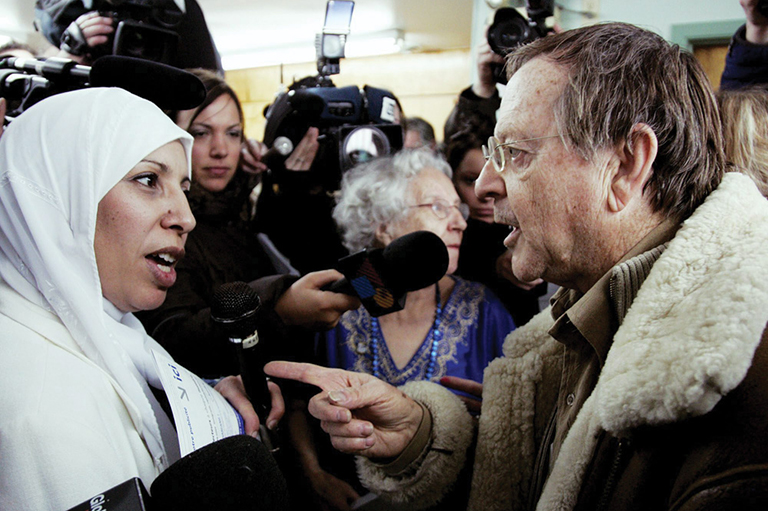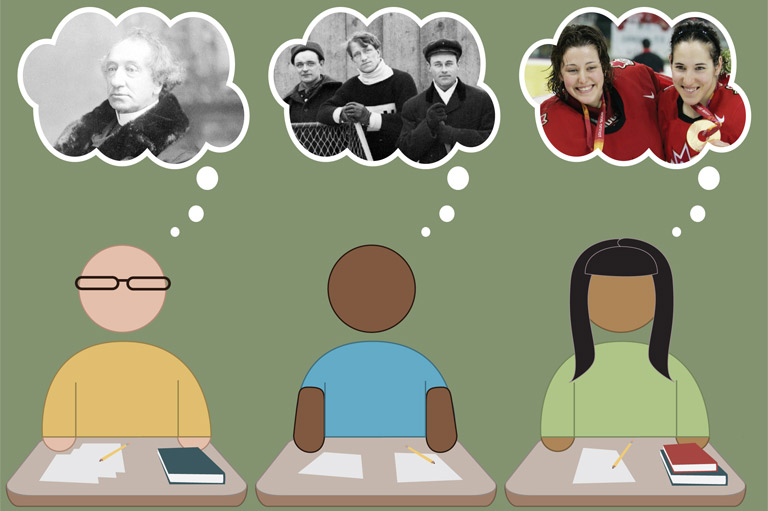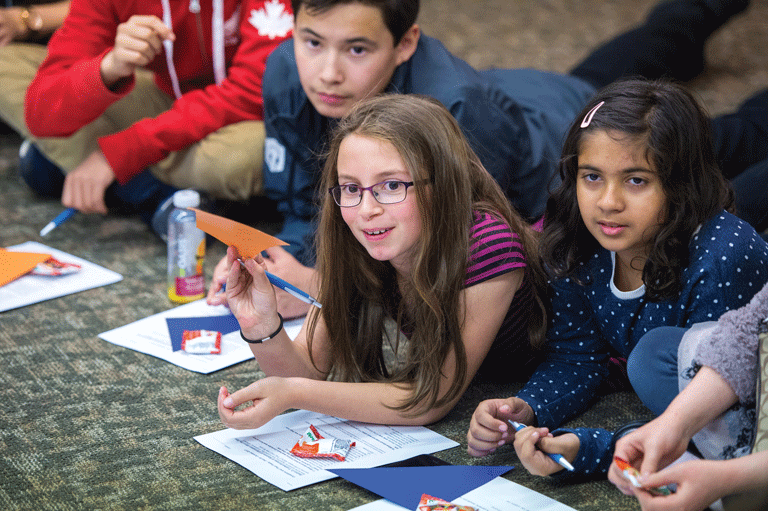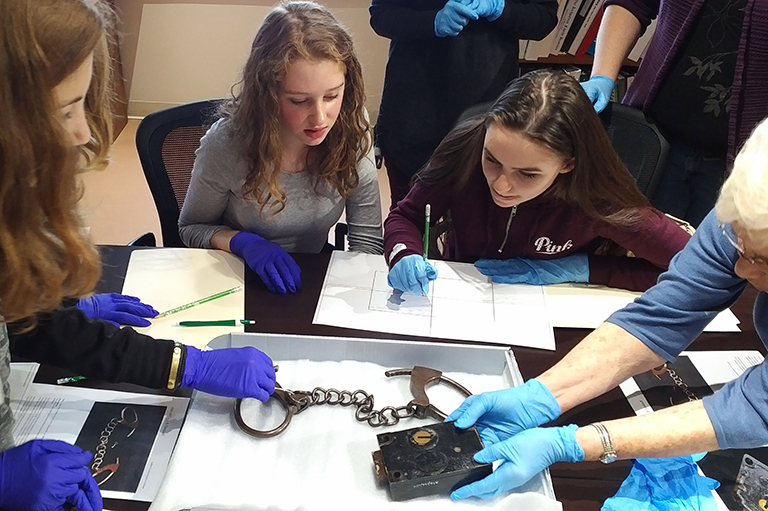Teaching Canada's History: 2024 Excellence in Teaching Finalists
Canada’s History recently spoke with the finalists for the 2024 Governor General’s History Award for Excellence in Teaching. This award recognizes teachers from across the country for their exceptional work in teaching Canadian history. It is also an opportunity to promote and facilitate the sharing of best practices and innovative teaching ideas within Canada’s history education community.
Listen in to learn more about the finalists and the projects they designed for their classrooms.
Alma Bernier
Isaac Brock, Winnipeg, Manitoba
Boozhoo Aaniin, Waabibineshii Ikwe dizhinikaaz, mahkwa doodem, Miimiiwziibiing doonjii. Hello my name is grey thunderbird woman of the bear clan from Berens River MB, Treaty 5 Territory. My English name is Orlene Alma Bernier and I live in Winnipeg MB. My project aspiration comes from the 94 calls to action and I persevere in teaching history from an Indigenous lens. The goal of the project was for my Indigenous students to identify who they are, where they came from, and how their history continues to affect their lives. We accomplished this by studying treaties, residential schools and Manitoba’s election of their first Indigenous premier. My responsibility is to teach truth and language to our youth to help break the cycles that have kept Indigenous people from knowing their true worths and identities. As a grandmother I share what knowledge and language I have because it is my right and duty to teach our children as it has always been done for centuries. Miigwech.
Jo Anne Broders
Smallwood Academy, Gambo, Newfoundland and Labrador
This emotionally powerful project remembers the Mi’kmaq people and their valued contributions to local history in Gambo, Newfoundland and Labrador. Jo Anne Broders’s grade 8 class collaborated with Chief Mi’sel Joe of the Miawpukek First Nation, and Fred Jeans of the Heritage Committee of Gambo, to make visible and commemorate the history of thirteen people buried at a Mi’kmaq cemetery. Before the project, no markers visibly detailed who was buried there and when they may have died. Students did a lot of investigating about the Mi’kmaq history in their community, creating family trees, poetry, wall art, essays, and display boards to share what they learned. After the project’s completion, and because of the collaboration, signs were erected providing a history of Madeline Joe and her extended family, including names, pictures, dates of birth, and dates of deaths. To conclude students' learning, a community service was also held honouring the Mi’kmaq people that rested there.
LouAnn Davis
St. Michael's Elementary School, Stephenville Crossing, Newfoundland and Labrador
LouAnn Davis’s project took place as part of the primary music program. The school has a high percentage of children with Indigenous ancestry, and it is important that they have the opportunity to learn about this culture, which was an opportunity that was denied to their parents and grandparents. For the project, students in the primary choir learned The Beatles' song “Blackbird,” which had been translated into Mi’kmaq, as well as the song “Seeds” by Indigenous Artist Julian Taylor. The song “Seeds” addresses residential schools and talks about the resiliency of Indigenous peoples. LouAnn Davis, with fellow primary teachers, used these songs as a springboard for thinking about and discussing residential schools, their Mi’kmaq culture and language, and how important it is to restore this culture and language within their school and community.
Alysa Ferguson
Juniper School, Thompson, Manitoba
The Truth and ReconciliACTION plan is an inclusive initiative that unites Indigenous and non-Indigenous students, Knowledge Keepers, Elders, community members, organizations, and School District of Mystery Lake representatives. Developed by Alysa Ferguson as part of the school's land-based learning program, participants engaged with and delved into authentic learning experiences with a hands-on approach. The program's primary objective was to fortify students' pride in their traditions, deepen their knowledge, and foster a stronger sense of place and belonging within the school community on Treaty 5 Territory. Following the Indigenous medicine wheel, the program aligned activities with the seasons, though adjustments are made based on students' inquiries, curiosity, and interests. Through this approach, students explored Canada's history and truths, aiming for understanding, healing, and personal growth to empower them as present and future change makers.
Ben Gross and Dan Kunanec
Don Mills Collegiate Institute, Toronto, Ontario
Ben Gross and Dan Kunanec developed an interdisciplinary collaboration between a World History course and a Hospitality and Tourism course. Anchoring learning in food history, students studied Ashkenazi and Sephardic life in Europe and how that history travelled to Canada with survivors of the Holocaust. After weeks of preparation, the classes combined for a day of cooking with Holocaust survivor Pinchas Gutter. In the wood-fired oven, students cooked cholent, challah, and kugel with Pinchas. The focus of the conversation was Pinchas’s memories of food in Poland as a young boy and his experiences of change and adaptation when he came to Canada. The students created a website documenting their learning, including recognition of deep connections between the experiences that they learned about and those of their own families.
Heather Howell
M. M. Robinson High School, Burlington, Ontario
The Heritage Garden Initiative is a project done in collaboration between the Museums of Burlington and Heather Howell’s horticulture therapy course offered through M. M. Robinson High School's Community Pathways Program — a program which offers an alternative curriculum to students with developmental and physical disabilities. Through this project, students learn about the importance of the horticultural history in Burlington while doing hands-on gardening work on the grounds of the Ireland House Museum. Lastly, in an effort to keep this project community-focused, what is harvested within the kitchen garden at the Museum is donated to the Burlington Food Bank.
David Lynch
St. Michaels University School, Victoria, British Columbia
Over the past six years, David Lynch has developed a year-long, multi-stage project-based approach to teaching B.C’s Social Studies 10. “Through their Eyes” engages students with the historical thinking concepts as they explore twentieth-century Canadian history through the real-life experiences of 225+ (extra)ordinary Canadians. These diverse individuals and their divergent experiences act as an enlightening window into the past, humanizing events and equipping students with concrete evidence that they use to assess, challenge, and even develop their own historical explanations and narratives.
Debbie Mar
Sema:th Elementary School, Abbotsford, British Columbia
Through a creative, interdisciplinary approach and with deep purpose, Debbie Mar’s grade 3/4 class paid tribute to local Second World War veterans by educating their school and community about the special friendship between Canada and the Netherlands — and the sacrifices made by Canadian citizens. The Tulip Project bloomed in 2018 upon the receipt of 75 red Liberator tulip bulbs from the BC Agriculture in the Classroom Foundation, commemorating the 75th anniversary of the liberation of the Netherlands during the Second World War. An impactful film — The Tulip Project — documenting students’ learning, has captured the hearts of Canadians. Inspired by previous classes, students continue to carry the torch of education, commemoration, and remembrance. The Tulip Project blooms to this day.
Christopher Martinello
St. Theresa of Lisieux Catholic High School, Richmond Hill, Ontario
Christopher Martinello’s class project is the Wendat Village Educational Archaeology Outreach Program. Before their school opened, archaeologists excavated a Wendat Village archaeological site on the property. The project introduced a new course in archaeological studies. Students re-created Indigenous technologies like atlatl spear throwers and tested them on the school’s field. The Ontario Archaeological Society and the Toronto Star have featured the project in their publications. Students constructed a museum gallery in the school foyer with artifact reproductions, designed one-page entries of the project for the school yearbook, and contributed to a school-specific Land Acknowledgement collaborating with the school board’s Indigenous community partners. Students helped generate a successful application to the Ontario Heritage Trust to establish a historical plaque on the grounds commemorating the Wendat Village.
Jessica McIntyre
Glebe Collegiate Institute, Ottawa, Ontario
Jessica McIntyre implemented Project True North in order to engage students in primary document research, to challenge accepted versions of Canadian history, and to share these stories — the truth of the True North — with the country. Over the last three years, English Language Learners and French Immersion students in her grade 10 Canadian History classroom have uncovered untold stories of the Great War by studying the lives of Canadian Nursing Sisters, members of the No. 2 Construction Battalion, and recipients of Great War medals housed at the Canadian War Museum. By poring over these documents, a story is created, and a person is remembered for their extraordinary sacrifice and bravery.
Michele Schwab
Balcarres Community School, Balcarres, Saskatchewan
Michele Schwab led a project that included preservation of traditional knowledge, community engagement, empowerment of elders, and intergenerational connections by bringing in kehte-aya (old ones or knowledge carriers) to capture their viewpoints and teachings on a variety of subjects. The goal was to capture the cultural significance, authenticity, and impact of the stories shared by local Indigenous kehte-aya. Schwab created relationships between the kehte-aya and the students that will go on beyond interview days while passing on traditional knowledge to a new generation. Her collection methods preserved cultural heritage, promoted intergenerational knowledge transfer, and increased cultural awareness. From these interviews the participants generated a podcast, created visual art pieces that showcased the students’ connections, and wrote and published persuasive and explanatory magazine articles that were shared with the school community, nations, and elsewhere.
Connie Shea
St. Malachy's Memorial High School, Saint John, New Brunswick
Connie Shea organized “The Hidden Histories Project,” a student-led public history and art initiative showcasing significant historical figures and events from marginalized and diverse communities in New Brunswick and Wabanaki Territory. The goal of the project was to find and celebrate important individuals and events not included in traditional textbooks and whose narratives have been "hidden" due to systemic inequality and discrimination. Students created a series of ten informative and digitally interactive postcards covering topics from First Nations history, Black history, women’s history, and the 2SLGBTQAI+ community. Over five hundred postcards were distributed to members of the public to share their knowledge and promote a deeper understanding and appreciation for the diverse historical narratives that shape our region’s collective past.
Sarah Stewart
St. Joseph Scollard Hall, North Bay, Ontario
Sarah Stewart asked her students to explore topics such as the ‘60s Scoop, the Métis struggle for recognition, the 1969 "White Paper,” and the High Arctic Relocation for an awareness campaign project. The purpose of this project was to encourage students to examine key issues that Indigenous Peoples in Canada have faced and to develop an understanding of how extensively racism has influenced government policies and society. In part one of this project, students filled in a planning sheet to gather information about their topic, determined its historical significance, and identified their target audience. Students utilized several historical thinking concepts to understand the context in which these injustices occurred. In part two, students wrote a recruitment letter to a potential spokesperson who could provide a platform to assist them in publicizing their message. In part three, students chose a media form (brochure, poster, podcast, etc.) to create their awareness campaign.
Laurie Thompson
Kikino School, Kikino Métis Settlement, Alberta
The seeds of the revitalization project began early in Laurie Thompson’s teaching career as she understood the critical value of heart and mind engagement of learners with the curriculum. This is especially true for Indigenous learners, and when Thompson returned to her home community to teach in 1998, she recognized an absence of wahkohtowin (relationships) between teacher, student, community, and culture. Assimilation policies, coupled with residential schools, took Indigenous children’s natural love of learning and twisted it into something indescribable. This project brings together students and elders, exploring both traditional cultural experiences and the history of the community. This project is only the beginning of the Métis Settlements of Alberta's trajectory to reclaim the word "school" as a good, healthy learning space inclusive of community culture and languages. We can learn from history.
Suzanne Uher
Traditional Learning Academy Online, Surrey, British Columbia
The Canadian Roundtable Debate project brings to light the major issues in Canada "today" while putting Suzanne Uher’s students into the shoes of Canadian politicians. Students are walked through an eight-week unit where they choose the major Canadian political party they wish to be a part of, and an MP from that party (present or past) who would be of interest to them to portray. In small party groups, they research an issue to become experts on and defend in the debate. Individually, students write news articles as their chosen MP to extend their knowledge; their work is then compiled in a class newspaper, The Hill Times. Debating as a "real person" is the highlight for the students, allowing them to dive into both Canadian history and current events.
Jason Vander Meulen
Waterloo Collegiate Institute, Waterloo, Ontario
In Jason Vander Meulen’s grade 10 history project, students developed an Investor Pitch for an early 20th century invention. The Investor Pitch was used as a creative medium to communicate historical findings because of connections to the recent, regional history of Waterloo. The area is the home of the BlackBerry and many start-up incubators; the tech sector has long been an important engine of the community. After exploring this regional history of innovation and learning the components of the start-up pitch, Vander Meulen introduced the concept of disruptive technologies and explored some modern examples. Students researched an invention or innovation from the first half of the last century. The inquiry coincided with a focus on ways of life and on social history, positioning the students for an immersive approach to the assignment. In their teams, students developed a historical persona and their pitch decks while incorporating the findings of their research.
Advertisement






